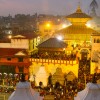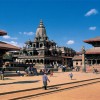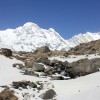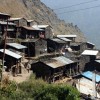Food & Restaurent
Indian food has a richly deserved reputation throughout the world for being aromatic and delicious. If you’re a vegetarian, you’ve come to the right place. Indians are used to people having special dietary requirements: yours will be respected, and no one will think you strange for having them. Indeed, some of the very best food India has to offer is vegetarian, and even confirmed meat-eaters will find themselves tucking into delicious dhals and veg curries with relish.
Most religious Hindus, and the majority of people in the south, do not consume the flesh of animals, while some orthodox Brahmins will not eat food cooked by anyone outside their household (or onions or garlic, as they inflame the baser instincts), and Jains are even stricter. Veganism is not common, however; if you’re vegan, you’ll have to keep your eyes open for eggs and dairy products.
Many eating places state whether they are vegetarian or non-vegetarian either on signs outside or at the top of the menu. The terms used in India are “veg” and “non-veg” , and we have adopted these throughout our eating reviews. You’ll also see “pure veg” which means that no eggs or alcohol are served. As a rule, meat-eaters should exercise caution in India: even when meat is available, especially in the larger towns, its quality is not assured except in the best restaurants and you won’t get much in a dish anyway – especially in railway canteens where it’s mainly there for flavouring. Hindus, of course, do not eat beef and Muslims shun pork, so you’ll only find those in a few Christian enclaves such as the beach areas of Goa, and Tibetan areas. Note that what is called “mutton” on menus is in fact goat.
Broadly speaking, there are four types of eating establishments: dhabas and bhojanalayas , restaurants, tourist restaurants and fast-food joints. Dhabas and bhojanalayas are cheap Indian diners , where food is basic but often good, consisting of vegetable curry, dhal (a lentil soup pronounced “da’al”), rice or Indian bread (the latter more standard in the north) and sometimes meat. Often found along the sides of highways, dhabas traditionally cater to truck drivers, and one way of telling a good dhaba from a distance is to judge from the number of trucks parked outside. Bhojanalayas , common in towns around the north and centre of the country, tend to be vegetarian, especially those signed as “Vaishno”. Both dhabas and bhojanalayas can be grubby – look them over before you commit yourself – and they tend to pile on the garam masala as a substitute for fresh spices. They do, on the other hand, have the advantage of being dirt cheap.
Restaurants as such vary in price and quality, and can be veg or non-veg, offering a wide choice of dishes, much like Indian restaurants anywhere else in the world. Deluxe restaurants such as those in five-star hotels can be very expensive by Indian standards, but they offer a chance to try classic Indian cooking of very high quality: rich, subtle, mouthwatering, and still a fraction of the price you’d pay for such delights at home – assuming you could find Indian food that good. Try a meal in one at least once.
The third type of eating place caters specifically for foreign travellers with unadventurous tastebuds: the tourist restaurant , found in beach resorts, hill stations and travellers’ meccas across India. Here you can get pancakes and fritters, omelettes and toast, chips, fried prawns, cereal and fruit salad. The downside is that they tend to be pricey, some miss the mark by a long way, and they are not, of course, authentically Indian.
The fourth type is international fast food including burgers (without beef) as well as pizzas, which seem to have taken cosmopolitan India by storm with familiar household names available in most major cities.
Finally, should you be lucky enough to be invited into someone’s home, you will get to taste the most authentically Indian food of all. Most Indian women are professional cooks and housewives, trained from childhood by mothers, grandmothers and aunties, and aided by daughters and nieces. They can quite easily spend a whole day cooking, grinding and mixing the spices themselves, and using only the freshest ingredients.
India Information
Our Top Offers
-

Buddhist Pilgrimage Tour
Lord Buddha was born in the western Nepal. This is the place belongs… Read More -

Hindu pilgrimage Tours
Hindu pilgrimage package tour is a perfect Tours package to be spent in… Read More -

Kathmandu Valley Tour
Nepal is steeped in numerous legends, myths and folklore that are entwined… Read More







